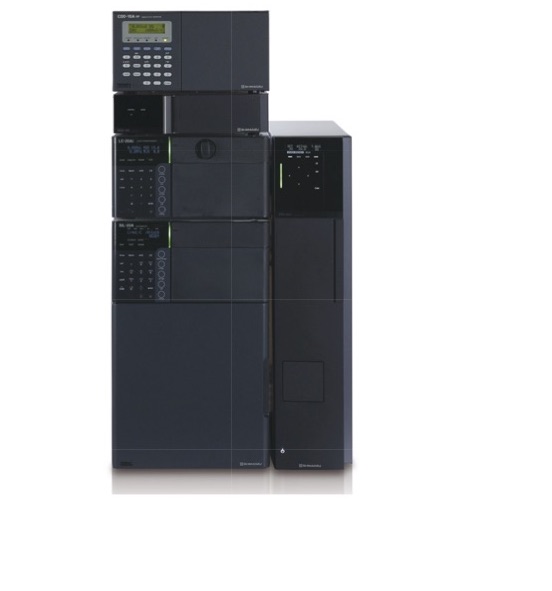
HIC-ESP
The HIC-ESP is a new anion suppressor ion chromatograph with built-in electrodialytic suppressor, boasting the same low carryover and excellent injection precision characteristic of Shimadzu HPLCs to bring you highly-reliable results. The newly developed anion suppressor prevents peak spreading and achieves high sensitivity, providing stable functionality even over long periods of use.
The HIC-ESP is suitable for applications in a wide range of fields including environmental science, medicine, chemistry and food science
HIC-ESP
The HIC-ESP is a new anion suppressor ion chromatograph with built-in electrodialytic suppressor, boasting the same low carryover and excellent injection precision characteristic of Shimadzu HPLCs to bring you highly-reliable results. The newly developed anion suppressor prevents peak spreading and achieves high sensitivity, providing stable functionality even over long periods of use.
The HIC-ESP is suitable for applications in a wide range of fields including environmental science, medicine, chemistry and food science
With a unique design where the eluent flow path bends back around, combined with optimized dialytic, the new ICDS-40A anion suppressor unit achieves achieves higher efficiency and stable suppressing while maintaining a small internal volume (patent pending). Combining this suppressor with high-quality HPLC units enables highly-reliable analytical results.
The ICDS-40A achieves high sensitivity, reliability and robustness
The ICDS-40A reduces peak spreading, increasing the sensitivity for components with low retention such as fluorine ions, and improves water dip separation, enabling highly-reliable results. Using an electrodialytic system which can carry out analysis and regenerations simultaneously, the analysis cycle time can be reduced and consecutive regeneration achieved, increasing the flexibility of the analysis time settings. In addition, the suppressor uses waste solution from the detector as regenerating solution, making environmentally-unfriendly regenerating solutions such as sulfuric acid unnecessary.
μS/cm 4
2
0
-2
-4
Shimadzu ICDS-40A
Other vendor's suppressor
1.2 x
Cl
NO2
F
Separation of F ion peaks is improved through narrower water dip shape.
Waste solution H2O+O2↑
H+
H+
H+ H+ 2H++1/202↑
H2O
H2O from detector
Electrode flow path
Na+
To detector
H2CO3
H2O from detector
H2O OH-+1/2H2↑
Na+ OH
Na+ OH
Na+ OH
Waste solution Electrode flow path
0.0
From column
Na+ HCO3
H Na+
2.0 4.0
6.0 min
H+
Na+
CDD Cell
+
–
The plot on the right shows peak response from analysis of a standard solution after each 100 injections of river water. Even after a long, continuous analysis of the sample, the peak intensity for each ion is stable. The excellent ion exchange function of the ICDS-40A is supported by the robustness of the HIC-ESP over a long analysis.
Pump
Autosampler
ICDS-40A Suppressor
Analysis column
Waste liquid
Eluant
700000 600000 500000 400000 300000 200000 100000
0
Flow structure of the HIC-ESP
Oven
Eluent flow path
F
Cl NO2 Br NO3 PO4 SO4
Structure and principles behind the ICDS-40A
4
0
200 400
600
800
1000
No. of river water sample injections
Cathode
Cation exchange membrane
Cation exchange membrane
Cation exchange membrane
Anode +
Peak area
High-quality HPLC units make up the HIC-ESP
This unique ion chromatograph combines various features indispensable to obtain highly-reliable analytical results: excellent solvent delivery performance, low carryover, injection speed (as low as 10 secs), sample injection precision and repeatability, precise oven temperature regulation and more.
μS/cm
300
200
Area (x100,000) 1.5
1.0
Injection volume (μL)
0.2 1 10
Area RSD(%) (n=5)
1.05 0.86 0.25 0.04 0.04 0.08
NO3–
Black: 1000 mg/L NO3–
Red: blank (ultra-pure water)
0.001%
8.0 10.0 12.0 14.0
100 0.5 20 50
0
75
0.0
0.0 5.0
10.0 min
0 10 20 30 40 50 60 70 Injection Volume (μL)
Low carryover
* Blank sample injected after analysis of 1000 mg/L NO3- standard solution.
Injection repeatability and volume precision
* Analysis changing the injection volume of the standard solution 10 mg/L Br